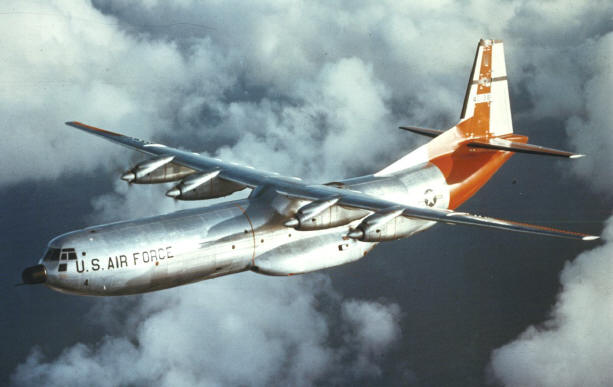|
|
| Douglas
C-133 Cargomaster |
|
 |
Conceived as an air transport for American
ICBMs, the C-133 Cargomaster was developed by the Douglas
Aircraft Company and first flown on 23 April 1956. It was the
second and largest turboprop transport to be accepted by the
U.S. Air Force. The C-133 was designed to meet the
requirements for the USAF's Logistic Carrier Support System
SS402L. The aircraft differed considerably from the C-74 and
C-124 Globemasters that had preceded it. A high-mounted wing,
external blister fairings on each side for the landing gear, and
rear-loading and side-loading doors ensured that access to, and
the volume of, the large cargo compartment were not compromised
by these structures. The cargo compartment (90 feet in length
and 12 feet high) was pressurized, heated, and ventilated.
The Cargomaster had a 13,000 cubic foot cargo
area with floor tie-down facilities permitting installation of
200 airline-type seats. The C-133 could accommodate 110,000
pounds of cargo or a fully-assembled Thor, Jupiter or Atlas
ballistic missile. Cargo was loaded via a two-section rear door
assembly, the lower section formed a ramp for drive-on/drive-off
capability, or by a cargo door on the port side of the forward
fuselage. The C-133 was able to accept practically every type of
vehicle in service with the U.S. Army. The Cargomasters went directly into
production as C-133A; no prototypes were built. The first
C-133As were delivered to the Military Air Transport Service
(MATS) in August 1957. A total of 35 were built: the last three
having a "clamshell" rear door assembly which
increased the compartment length by 3 feet, making it possible
to airlift completely assembled Titan missiles. These were
followed by 15 C-133B aircraft that retained the
"clamshell" doors and incorporated more powerful
engines. In 1958, C-133s began flying MATS air routes
throughout the world, and two C-133s established transatlantic
speed records for transport aircraft on their first flights to
Europe. The fleet of 50 aircraft proved itself
invaluable during the VietNam War, but fatigue problems led to
their withdrawal from service in 1971.
|
|
Sorry.
No models are available for this aircraft. |
|
